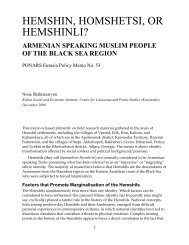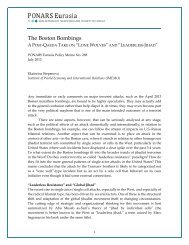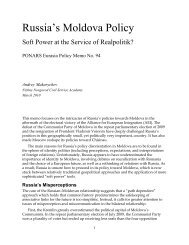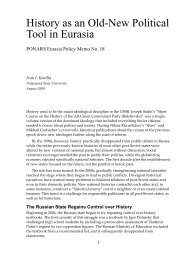Drug Trafficking in Central Asia - PONARS Eurasia
Drug Trafficking in Central Asia - PONARS Eurasia
Drug Trafficking in Central Asia - PONARS Eurasia
Create successful ePaper yourself
Turn your PDF publications into a flip-book with our unique Google optimized e-Paper software.
first political <strong>in</strong> nature. This does not only mean gett<strong>in</strong>g the pr<strong>in</strong>cipled consent of<br />
<strong>Central</strong> <strong>Asia</strong>n governments. It also requires establish<strong>in</strong>g measures similar to those <strong>in</strong><br />
Colombia several years ago or those Mexico tries to implement today: forcibly<br />
separat<strong>in</strong>g crim<strong>in</strong>al networks from their pawns <strong>in</strong> the state apparatus and fight<strong>in</strong>g real<br />
wars, likely with casualties, aga<strong>in</strong>st drug cartels.<br />
Such an approach is unlikely to obta<strong>in</strong> the support of <strong>Central</strong> <strong>Asia</strong>n rul<strong>in</strong>g elites<br />
today, however, and the <strong>in</strong>ternational community cannot force it upon them. Border<br />
security thus will rema<strong>in</strong> the lowest common denom<strong>in</strong>ator for <strong>in</strong>ternational cooperation,<br />
requir<strong>in</strong>g important f<strong>in</strong>ancial commitments for more than limited effectiveness.<br />
From Supply to Demand<br />
International efforts to combat drug traffick<strong>in</strong>g from Afghanistan are dist<strong>in</strong>ctly focused<br />
more on production and manufacture than they are on demand reduction, treatment,<br />
and prevention campaigns. Strategies of prevention and treatment are considered<br />
national issues dependent on public policy, while the fight aga<strong>in</strong>st drug traffick<strong>in</strong>g is<br />
held to be the legitimate prov<strong>in</strong>ce of <strong>in</strong>ternational and regional organizations. Thus, for<br />
example, UNODC’s budget for <strong>Central</strong> <strong>Asia</strong> allocates only 11 percent of its funds to<br />
prevention, while 88 percent is assigned directly to the fight aga<strong>in</strong>st drugs as well as<br />
aga<strong>in</strong>st organized crime, corruption, and terrorism.<br />
International actors’ strategies for fight<strong>in</strong>g aga<strong>in</strong>st traffick<strong>in</strong>g have been subject<br />
to contradictory <strong>in</strong>terpretations. Russia, for example, wants NATO to go directly after<br />
production by destroy<strong>in</strong>g poppy fields and laboratories. In this context, the Russian<br />
government has put forward a “Ra<strong>in</strong>bow-2” plan, a large scale poppy eradication<br />
program, and has lobbied the UN Security Council to have Afghan production declared<br />
a threat to global peace and security. Such a decision would enable sanctions to be<br />
imposed on Afghan landowners who authorize the cultivation of opium, as well as<br />
legitimize the destruction of poppy fields. However, NATO has refused to accede to<br />
Russian demands, on the pretext that it would be necessary to provide Afghan farmers<br />
alternative sources of revenue or risk worsen<strong>in</strong>g the image of the organization among<br />
the Afghan population. It has stated that it wants to focus eradication efforts aga<strong>in</strong>st<br />
drug storage sites, so that the losses <strong>in</strong>flicted are targeted only at crim<strong>in</strong>al sett<strong>in</strong>gs.<br />
When it comes to treatment, all <strong>Central</strong> <strong>Asia</strong>n states are affected by their Soviet<br />
heritage. As the studies of historian and anthropologist Alisher Latypov have shown,<br />
the Soviet past, which places the medical and psychiatric doma<strong>in</strong>s at the service of law<br />
enforcement agencies, still carries great <strong>in</strong>fluence. The tendency to crim<strong>in</strong>alize drug<br />
addicts complicates the implementation of effective prevention strategies. Alleg<strong>in</strong>g a<br />
synergy between <strong>in</strong>surgency, terrorism, and drugs does not lend itself to form<strong>in</strong>g new<br />
approaches or creat<strong>in</strong>g more appropriate support structures for persons requir<strong>in</strong>g care.<br />
Several <strong>Central</strong> <strong>Asia</strong>n states, for <strong>in</strong>stance, require treatment centers to transmit the<br />
names of drug addicts to security organizations. Moreover, treatment centers are poorly<br />
equipped and oriented around abst<strong>in</strong>ence and zero tolerance. While Kyrgyzstan has<br />
accepted opioid substitution therapy, the latter rema<strong>in</strong>s quite controversial <strong>in</strong> most post-<br />
Soviet states, and Turkmenistan, Uzbekistan, and Kazakhstan are vehemently opposed<br />
4










